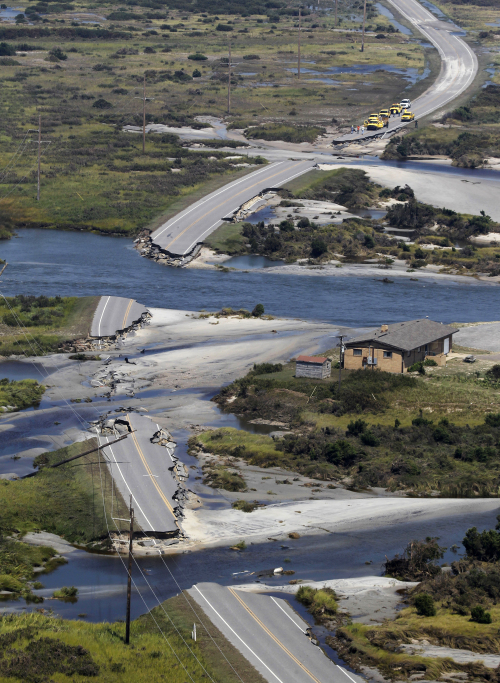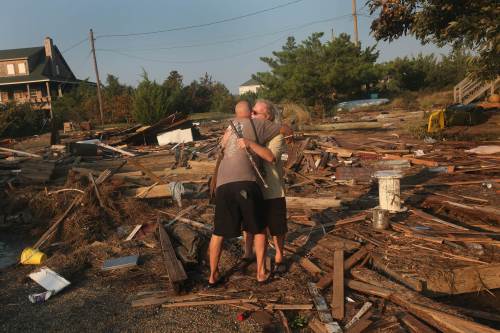21 lives claimed and $7 billion lost, but N.Y. largely unscathed
NEW YORK (AP) ― Stripped of hurricane rank, Tropical Storm Irene spent the last of its fury Sunday, inflicting relatively little damage to New York but leaving a trail of treacherous flooding and millions without power along America’s East Coast.
Slowly, the East Coast surveyed the damage, up to $7 billion by one private estimate. For many the danger had not passed: Rivers and creeks turned into raging torrents tumbling with limbs and parts of buildings in northern New England and upstate New York.
“This is not over,” President Barack Obama said from the Rose Garden.
The storm left behind a stunned U.S. East Coast. At least 21 people died, severe flooding was widespread and 4 million homes and businesses lost power.

Parts of a road in North Carolina are flooded after Irene stormed by on Sunday. (AP-Yonhap News)

A man is comforted by his friend as he stands on what is left of his cottage in North Carolina on Sunday. (AFP-Yonhap News)
As waves continued to pounded the shores east and north of America’s biggest city, New York City Mayor Michael Bloomberg lifted the evacuation order for 370,000 people in low-lying areas.
Irene sent seawater surging into lower Manhattan’s streets, but the city appeared to escape the worst fears of urban disaster ― vast power outages, hurricane-shattered skyscraper windows and severe flooding.
By Sunday night officials said New York would start its subways again Monday and the New York Stock Exchange was ready to open for trading.
New England residents were feeling the brunt of the diminished but still-dangerous storm, which will cause flooding and winds that could topple many towering trees anchored in soil already saturated by earlier heavy rains. The storm was expected to move over eastern Canada by Sunday night.
In Massachusetts, the National Guard had to help people evacuate. The ski resort town of Wilmington, Vermont, was flooded, but nobody could get to it because both state roads leading there were underwater.
“This is the worst I’ve ever seen in Vermont,” said Mike O’Neil, the state emergency management director.
The National Hurricane Center said Sunday night that Irene was maintaining 80 kph maximum sustained winds as it neared the U.S.-Canada border. Tropical storm warnings were issued for the south coast of New Brunswick and Nova Scotia.
Forecasters said the storm, stripped of hurricane rank hours earlier, was moving north-northeast at 42 kph. It was located 32 kilometers south of St. Johnsbury, Vermont.
Chris Fogarty, director of the Canadian Hurricane Center, warned of flooding and wind damage in eastern Canada. He said the heaviest rainfall was expected in Quebec as high winds and pounding surf were more of a concern in Nova Scotia and New Brunswick. As of Sunday afternoon, at least 180,000 customers in Quebec had lost power.
As the eye of the sprawling storm blew through America’s largest city and Long Island to the east, it pushed an Atlantic storm surge toward New York. Briny water from New York Harbor submerged parts of a promenade at the base of the island of Manhattan. 30 centimeters of water rushed over the wall of a marina in front of the New York Mercantile Exchange, where gold and oil are traded.
The huge storm had threatened 65 million people up and down the Atlantic coast, estimated as the largest number of Americans ever affected by a single storm.
In an early estimate, consulting firm Kinetic Analysis Corp. figured total losses from the storm at $7 billion, with insured losses of $2 billion to $3 billion.
The storm will take a bite out of Labor Day tourist business from the Outer Banks to the Jersey Shore to Cape Cod.
Even after the storm passes in the Northeast, the danger persisted. Rivers could crest after the skies the clear, and the ground in most of the region is saturated from a summer of persistent rain. In Rhode Island, thick with bays, inlets and coastline, authorities were worried about coastal flooding at Sunday evening’s high tide. The ground was soggy in some areas even before the storm because of an extremely rainy August.
New York was eerily quiet as the storm hit. In a city where many people don’t own cars, the population stayed indoors.
The entire transit system was shut down because of weather for the first time ever.
All of the city’s airports were closed, with more than 9,000 flights canceled. Broadway shows, baseball games and other events were all canceled or postponed.
As the center of the storm passed over Central Park at midmorning, floodwater reached the wheel wells of some stranded cars in Manhattan, and more streamed into the streets of Queens.
Still, the storm didn’t come close to inflicting the kind of catastrophic damage that had been feared in the city. The Sept. 11 museum, a centerpiece of the rebuilding of the World Trade Center site, said on Twitter that none of its memorial trees were lost.







![[Graphic News] More Koreans say they plan long-distance trips this year](http://res.heraldm.com/phpwas/restmb_idxmake.php?idx=645&simg=/content/image/2024/04/17/20240417050828_0.gif&u=)